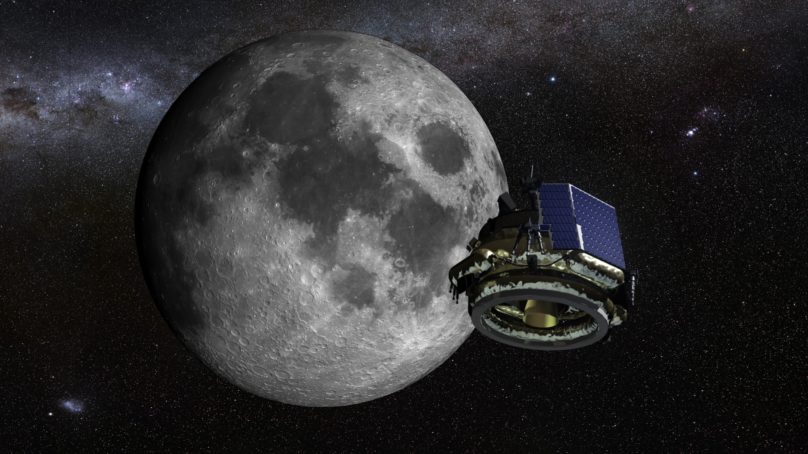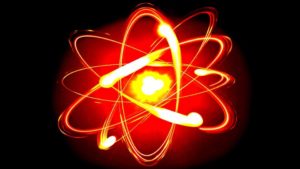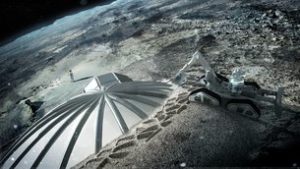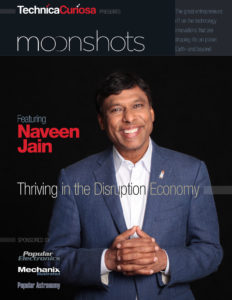
Later this year, Naveen Jain, CEO of Moon Express, expects to launch the world’s first private commercial initiative to unlock the vast hidden resources on the moon—resources spanning magnesium to platinum to titanium to helium-3—and ultimately develop a space colony there to support mining operations, particularly for helium-3.
What’s so special about helium-3?
Today, nuclear power plants rely upon a nuclear reaction—fission—to produce heat, which turns water into steam, which in turn drives a turbine to produce electricity. The downside to this process is a byproduct called radioactive waste. In nuclear fusion, on the other hand, hydrogen isotopes are used—the same energy source that fuels the sun. And it is not radioactive: in fusion, there are no neutrons generated as a reaction product, and consequently, it produces no nuclear waste.
 Not only is fusion clean, it is astoundingly efficient. “Imagine,” Jain says, “replacing a coal train more than a kilometer long, loaded with 5,000 tons of coal, with just 40 grams of helium-3. Just 25 tons of helium-3 could power the United States and Europe combined for a year! And with more than a million tons of the stuff on the moon, we could keep up this pace for 40,000 years. Energy problem solved.” But we’ve got to go to the moon to get it.
Not only is fusion clean, it is astoundingly efficient. “Imagine,” Jain says, “replacing a coal train more than a kilometer long, loaded with 5,000 tons of coal, with just 40 grams of helium-3. Just 25 tons of helium-3 could power the United States and Europe combined for a year! And with more than a million tons of the stuff on the moon, we could keep up this pace for 40,000 years. Energy problem solved.” But we’ve got to go to the moon to get it.
Thank Earth’s magnetic field for helium-3’s scarcity. Helium-3 is emitted by the sun and scattered throughout our solar system by the solar winds. That wind, however, is repelled by the Earth’s magnetic field; only a tiny amount of He-3 makes it through our atmosphere in the form of cosmic dust. The moon, however, has a weak magnetic field and no atmosphere. That makes it a fertile receptor of everything the solar wind blows its way, hence the massive deposits of helium-3. All that remains is mining it and transporting it to Earth.
 The good news is that the mining technology and knowhow already exists, and of course, robotic machines would perform the work. The processes involved in separating helium-3 from its ore are equally straightforward, and easily and economically accomplished. In fact, one analyst suggested that the total investment would be comparable to building a major transcontinental pipeline—but one with a vastly more productive payback. And we’d get a permanent lunar base in the bargain—a base that could serve every need from resupply to launches to training to unimagined potentials for scientific discovery.
The good news is that the mining technology and knowhow already exists, and of course, robotic machines would perform the work. The processes involved in separating helium-3 from its ore are equally straightforward, and easily and economically accomplished. In fact, one analyst suggested that the total investment would be comparable to building a major transcontinental pipeline—but one with a vastly more productive payback. And we’d get a permanent lunar base in the bargain—a base that could serve every need from resupply to launches to training to unimagined potentials for scientific discovery.
What’s more, the moon has massive amounts of water locked up in ice that cannot only be used in the production of rocket fuel (water being composed of hydrogen and oxygen—rocket fuel’s essential ingredients), but provide crucial life support. Just like the bits that fuel the Internet economy, water is the oil for the space economy.
Jain adds, “I am thrilled that our children are getting to experience the same excitement that we witnessed in the 1960s with the Apollo program. There was a tremendous spirit of optimism and great excitement around the planting of the American flag on the surface of the moon. But this shouldn’t be just an American dream. I would love to see the American dream become a global dream.”
To this end, Jain—who views the moon as Earth’s 8th continent—observes that entrepreneurs don’t have boundaries. “Entrepreneurs work with everyone who believes in them, who believes in the cause,” he says. “Moon Express is funded by entrepreneurs from all over the world—entrepreneurs from China, Russia, India, Germany, France. We all believe that this is possible and we all came together to make it happen. Capital is not patriotic. Capital goes where the opportunities are. Boundaries are created by politicians for their own purposes. Entrepreneurs don’t create boundaries; they expand them far beyond any visible horizon on Earth or beyond.”
To learn more of Jain’s vision, check out our new eBook series, Moonshots— the Great Entrepreneurs Riff on the Technology Innovations that are Shaping Life on Planet Earth—and Beyond.
About Moonshots—the Series
 The term “moonshot” has its genesis in the Apollo program—the daring endeavor that involved not only a highly volatile mixture of fuels to get it off the ground, but the even more volatile combination of technologies, engineering, basic science, politics, and economics required to bring it to fruition. Such undertakings are, at the outset, inherently difficult, unproven, risky, and even audacious—perhaps at times outrageously so—but they also carry tremendous potential for changing the world and moving humanity forward.
The term “moonshot” has its genesis in the Apollo program—the daring endeavor that involved not only a highly volatile mixture of fuels to get it off the ground, but the even more volatile combination of technologies, engineering, basic science, politics, and economics required to bring it to fruition. Such undertakings are, at the outset, inherently difficult, unproven, risky, and even audacious—perhaps at times outrageously so—but they also carry tremendous potential for changing the world and moving humanity forward.
Google X, a semi-secret R&D wing, has adopted the term to define their modus operandi in developing and de-risking early-stage ideas, with a view to parlaying them into solutions that solve real problems. “We look for the intersection of a big problem, a radical solution, and breakthrough technology,” their statement begins. “We start with a large problem in the world that if solved could improve the lives of millions or even billions of people. Then we propose a radical solution that sounds impossible today, almost like science fiction. Lastly, we look for a technology breakthrough that exists today; this gives us the necessary hope that the solution we’re looking for is possible, even if its final form is five to ten years away and obscured over the horizon.”
To such ends—and to reaching such horizons—the ideas offered in this special series are seeds—seeds in search of fertile ground. When those seeds are properly sown, watered, and exposed to sunlight, they stand a good chance of bearing fruit. But those same seeds—the ideas and elements that make up the entrepreneurial mindset—often lie dormant as mere potential until they are activated.
It’s the activation part of the equation that we’re concerned with here on the Moonshots stage. That’s why we’ve invited the world’s great technology entrepreneurs to share the fascinating ways they harness innovations as they work to transmute the big problems challenging humanity into equally big solutions.
As Naveen Jain points out in the inaugural edition of this series, “We are living in the most innovative decade in human history.” We are indeed witnessing in our day a Cambrian explosion of new technologies, which translates into corresponding and exponentially growing opportunities for innovation. And when entrepreneurs discover ways of combining these technologies to synthesize new and useful solutions, opportunities multiply again.
Our tagline at Technica Curiosa is “Unleashing Your Potential to Change the World.” We strive to do that by presenting valuable content designed to inform, enlighten, inspire, and advance practical knowledge. Equally important, because we know that innovation comes from connecting disparate and non-obvious dots, we endeavor to cross-pollinate big ideas across disciplines in relevant and stimulating ways. And that’s because, as our guests will show time and time again, innovation doesn’t take place so much within disciplines as it does at the intersections and boundaries between them.
This is the big idea we’ll amplify through the voices of its master practitioners—the world’s great technology entrepreneurs. We hope you’ll find their insights to be as inspiring as we have.
Download the eBook now—it’s free!



